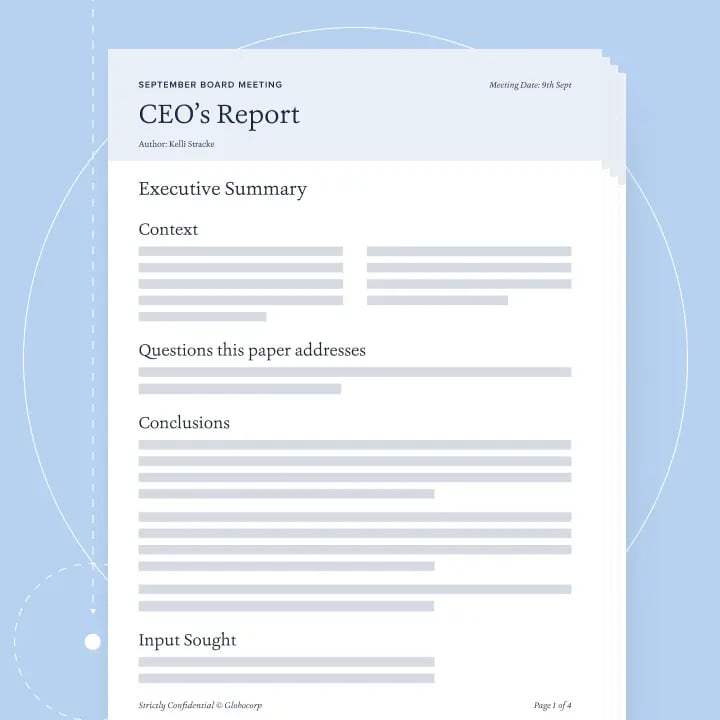Agility is big business, with the global market for agile transformation estimated to be worth nearly $30bn annually.
But strip back the jargon-heavy methodologies, and it’s much simpler than the consultants and tech vendors would have you believe.
An organization’s ability to get things done isn’t determined by the CEO’s views on agile versus waterfall, or by the number of Six Sigma Black Belts in the executive team. Rather, it’s driven by your ability to harness your team's collective intelligence, i.e., your ability to get everyone in the business applying their thinking to the problems and opportunities that matter most.
This sounds simple enough. But new research by Board Intelligence shows that not many organizations are moving as fast and smart as they need to.
Do business leaders think their organizations are agile?
Over the past year, nearly 100 business leaders have completed Board Intelligence’s Agility Friction Test. They’ve rated their organizations’ overall agility and identified friction hotspots by answering questions about their team’s critical thinking, communication, and focus. Together, these capabilities underpin collective intelligence.
The findings show that agility, while highly sought after, is a frustratingly elusive goal.
Just 4% of business leaders reported low levels of friction overall. In contrast, nearly two-thirds (57%) reported high levels of friction. One-quarter (26%) recorded high levels of friction across all three dimensions, namely critical thinking, communication, and focus.
What’s slowing businesses down?
For most businesses, the problem is focus, or a lack thereof. 77% of respondents reported high levels of friction in this area, and two-thirds (66%) of those who reported high levels of friction overall named focus as their friction hotspot.
It seems the problems begin in the boardroom:
- 91% thought their board should spend less time “in the weeds” and focus more on the organization’s big-picture vision and goals.
- 92% admitted they often lost sight of those goals in the routine of the day-to-day.
Decision-makers aren’t just struggling to stay focused on what matters; they’re also concerned that the wider team is pulling in a different direction.
- 83% were worried that their organization’s values hadn’t filtered down through the ranks.
- Only 29% believed that they’d implemented robust enough processes to ensure that key decisions aligned with those values.
What about critical thinking and communication?
Of course, agility blockers aren’t limited to focus and alignment. When it comes to critical thinking and communication:
- Only 12% believed they had the quality of thinking they needed throughout their organization.
- 79% said they don’t have the time to routinely step back from the day-to-day and think.
- 93% of organizations recorded high or medium levels of friction around internal communication, and 87% around critical thinking.
So, we struggle to find the time to think about the things that matter, and when we do, we don’t think hard enough or make it count.
For many leaders, these challenges are exposed in management meetings and reports, the routines through which businesses are run. Our research found that, rather than providing important fuel for the business, these activities are actually slowing them down:
- Only 14% of management teams produce well-thought-out plans that decision-makers can act on.
- Less than one-third (31%) of business leaders think their management reports are easy to read and understand.
- 85% believe their internal reporting drowns decision-makers in too much detail.
What’s the solution?
The good news is that fixing all of these points of friction is within a business leader’s gift. And it's easy to find the tools to help them do it.
The first step is to adopt the Question-Driven Insight (QDI) Principle, Board Intelligence’s methodology for high-quality thinking and communication. QDI is a playbook for creating the conditions that unleash collective intelligence. It’s been embedded by a wide range of large organizations, including Fortune 500s and government departments, to improve organizational agility.
“We get to the crux of the discussion more quickly and make all the decisions we need.”
~ Executive, Reckitt, FTSE 100 — read the case study
The second step is to make the QDI Principle an integral part of your organization's routines, so you can get everyone thinking well, at all times. Board and management reporting are ideal examples of the sort of routine business activity that can be repurposed to build collective intelligence.
Our AI-powered software platform, Lucia, is designed to do just this, guiding the thinking and writing that goes into board and management reporting. Lucia transforms reporting from a backward-looking time sink into a productive activity that drives insight and action.
It uses real-time AI-based feedback to help authors think and write well, aligning their thinking and the insights they generate with the organization’s goals.
This helps decision-makers at every level of the business have better conversations about the things that matter most, and ultimately get more done.




